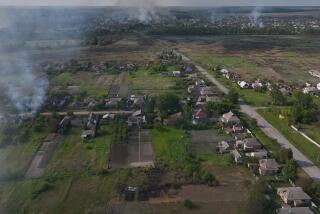ENVIRONMENT : Red Army Leaves Big Mess Behind
- Share via
BERLIN — When the last trainload of Red Army troops rolled across the Polish border from Germany on Thursday, the Russians left unanswered a major question: what to do with all the vacated real estate--1,026 scattered tracts of land totaling 667,000 acres, pocked with tumbledown buildings, toxic dumps and many thousands of unexploded artillery shells?
Germany was studying this dubious windfall even before the Russians boarded their trains home. In the last three years, Bonn spent $700 million just to keep the ground water safe. And now, after inspecting 925 former Red Army posts, officials have turned up 24,000 assorted environmental hot spots--anything from oil spill sites to haphazard caches of chemicals.
About 3,000 of these locations are said to pose “acute danger” to the surrounding population.
And then there’s the unspent ammunition.
“The Russian, in my experience, goes about the decommissioning of ammunition according to the principle of ‘ocular isolation,’ ” complains Guenter Knueppel, a forestry official in Colbitz-Letzlinger Heide, a flatlands area where the Warsaw Pact forces used to stage major maneuvers twice a year. “He digs a hole in the ground, and if he doesn’t see the ammunition anymore, it’s gone.”
German officials say any serious cleanup will cost billions of marks. And who has that kind of money? Certainly not private investors, as state and local governments in the former East Germany have discovered, to their chagrin. They had hoped that private developers might turn some of the former Russian bases into resorts, industrial parks, low-income housing estates, theme parks and nature preserves. But in most cases, the potential cost has proven too forbidding and the land too far removed from population centers for economic viability.
And so it has come to pass that the most enthusiastic prospective occupant for the Russian lands is the German army, which sees an opportunity to expand its own assets.
Already, the army is reclaiming 12 Russian training grounds, totaling 355,000 acres, for training purposes. One 55-square-mile MIG bombing range northeast of Berlin, known as Wittstocker Heide, is now used by the Luftwaffe for practicing tactical air strikes, ground-support sorties and other maneuvers.
This doesn’t sit well with the neighbors. For decades, East Germans put up with the roar of Red Army tank columns and the shriek of low-flying jet fighters, and now they wonder why they should accept more of the same from their own forces.
“People are really embittered,” says Reinhard Lampe, a Protestant minister in the village of Dorf Zechlin, which lies on the edge of Wittstocker Heide. “The Russians never asked anybody whether they could do this or not. Now the German army has just taken over, using Stalin’s methods.”
Angry Germans have responded to the army’s arrival with candlelight vigils, road blockades, petitions, a “Woodstock for Wittstock” concert and even threats.
These tactics have proved futile, however, and now the opponents have turned to the German judiciary, filing land claims and trying to win court orders to protect the ground water or to have some bases set aside as cultural heritage sites.
Most recently, the army planted the flag atop the 89-square-mile Colbitz-Letzlinger Heide, where it plans to build a high-tech center for tank maneuvers and laser-simulated target practice.
But state officials for Saxony-Anhalt argue that 45 years of Soviet and Warsaw Pact environmental insult have left the ground water at risk.
No problem, said the army. It would bring federal funds to clear away the Russians’ mess. The army estimated that a cleanup would cost $100 million to $200 million.
State officials argued that a proper job would cost $900 million and entered talks with their federal counterparts.
On the very day of the talks, the army moved onto the base.
More to Read
Sign up for Essential California
The most important California stories and recommendations in your inbox every morning.
You may occasionally receive promotional content from the Los Angeles Times.










